- 8 Minutes to read
- Print
- DarkLight
- PDF
Dynamic Planning Report, Run
- 8 Minutes to read
- Print
- DarkLight
- PDF
Article Summary
This article explains how to use the Run subtask in SpotlightXL to execute reports, drill through to detailed data, refresh content, save changes, and use Breakback for top-down adjustments. It also covers taking and sharing snapshots, using the Metadata Viewer, and converting reports into Excel Reports via Capture Data or Capture Entire Workbook.
Overview
With the Run subtask you can execute reports by selecting the Report task and the Run subtask. Then select a report from the folder drop-down.
How to Work with Model, View, and Report Folder and Organization Functionality
Selecting a Different Value for a Substitution Variable at Runtime
Report Actions
A description of the actions available for the Run subtask is provided below.
Drill Through
If you do not see Drill Through on the menu, then the report does not have drill-through data available. The data available on the Drill Through detail page is based on how the model was set up. Master Models that take their data from HACPM_Financial or from an external data source can use Drill Through.
In Practice: Drilling Through Detail Data in a Report
Select the Report task and the Run subtask.
Select a report.
Select one or more data cells.
Click Drill Through.
The Drill Through detail page opens, if available.
Click Go Back to close the Drill Through detail page.
Note:
The Drill Through will display either code or display label based on the display property of the view or report. Also, the display label will be based on the source model (HACPM) model. In the image below, Display Label is selected for Display on the Report Properties page so Display Label is displayed when Drill Through is performed on that same report. Access the Report Properties page when designing the report.
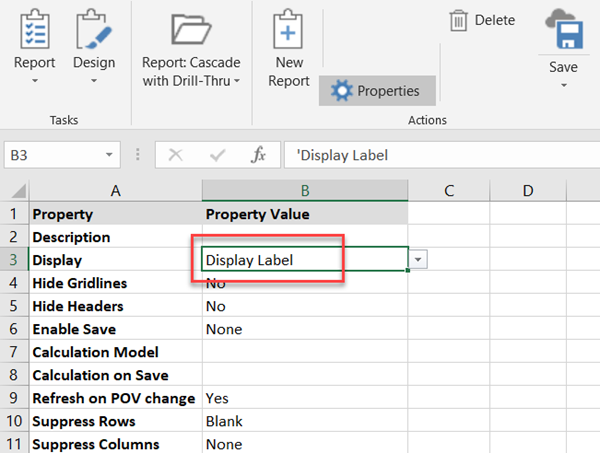
Substitution Variables
This action opens the Substitution Variables box, where users can select a value for a variable. For example, a report may show data for a certain month or department. Using Substitution Variables, the user can select a different month or different department to view.
This icon is available only if Substitution Variables are defined in the report.
Refresh/Refresh All Open Reports
This action updates data in the worksheet after selections are made.
If multiple sheets with reports are open, select Refresh All Open Reports to update data in each sheet.
Save Data
If you do not see Save Data on the menu, then the report does not have Save enabled. See Enabling Menu Items in Views and Reports: Save Data and Breakback.
This action saves modified data to reports, provided that Enable Save is set to Calculation Model or All Models in the Report Properties. Users can save changes only to leaf-level data.
If a user tries to save data changes to rollup members the report, a message appears informing them that the changes have not been saved. The change they made remains on the screen but has not be committed to the model.
When the rollup notification appears, if the Save action was set to also a run a calculation, the calculation will not be run.
Note:
If you want the calculation to still be run on a report with all rollups, then disable the Save action.
If the report consists of combination of leaf-level and rollup-level cells, then the validation is not run. The leaf-level cells will be saved and the rollup level cells will not be saved.
This validation is applicable only when Enable Save is set to Calculation Model. If Enable Save is set to All Models, no validation is performed.
Breakback
If you do not see Breakback on the menu, then the report does not have Save enabled. See Enabling Menu Items in Views and Reports: Save Data and Breakback.
This action opens the Breakback box where you can select a spreading method and allocate changes in numeric data from the top down.
For details, see Breakback from View or Report.
Snapshot - Send Email/Save
Take a snapshot of a report and keep it or share it with other users.
Note:
You cannot interact with a snapshot as though it was a report. It is like an image of the report only.
Select from two options.
Select Save to save the snapshot to the report folder structure.
Select Email to receive an email with a link to the snapshot, which you can share with other users of the application.
More
This action groups together the Metadata Viewer, Capture Data, Capture Entire Workbook, and Copy Formulas commands.
More - Metadata Viewer
This action opens the Metadata Viewer. When users are running a report, they may want to see additional information about the POV, rows or columns headings, or data cells. The Metadata Viewer is available to provide information about the model and dimensions that make up the SpotlightXL cells. Metadata Viewer is similar to the Design Manager in Report Design but everything the user sees in the Metadata Viewer is read-only. To use the Metadata Viewer, select one or more SpotlightXL cells, then select the More menu, and Metadata Viewer.

The Metadata Viewer tells the user which model is being used and the particular dimension members that make up the data intersection.
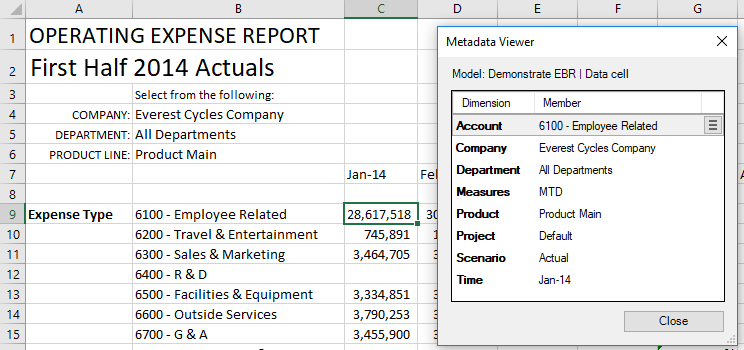
Users can also select a whole group of cells and then select Metadata Viewer. The viewer then displays all dimension members in use.
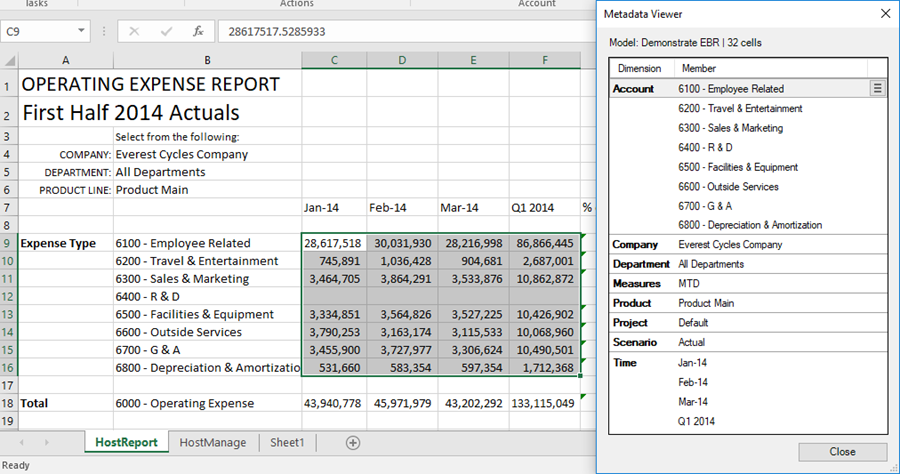
If the user would like to identify which cells are associated with a particular dimension member, they can click the Member Select icon and then use the Filter Member option. The screen then refreshes and the user sees highlighted cells indicating which cells are from that dimension member.
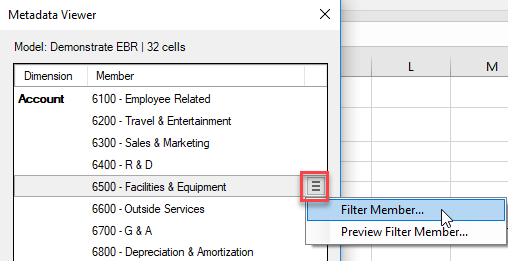
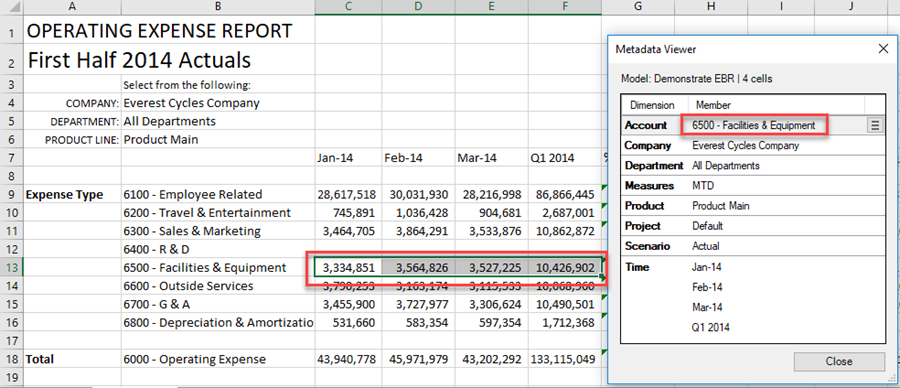
If your report uses data from multiple models, you can select data cells from both models and see each in the Metadata Viewer. Select a model from the Model drop-down list.
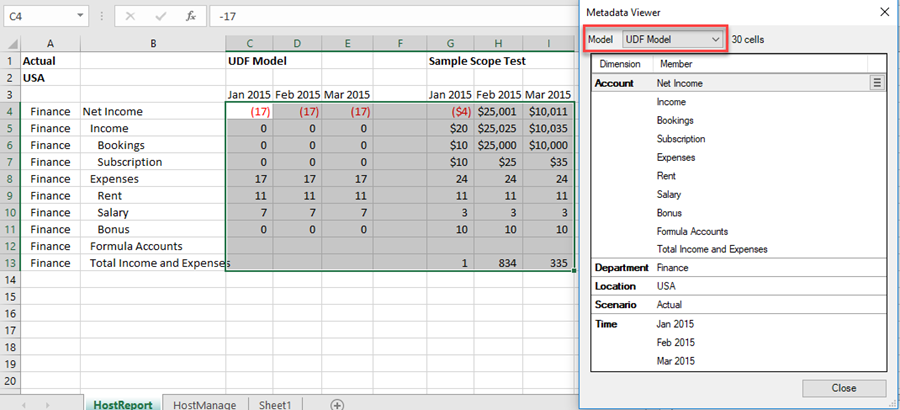
More - Capture Data/Capture Entire Workbook
This action captures metadata for report intersections and converts the report to an Excel Report. You can Capture Data from either Run mode or Design mode.
With this option, you can convert your existing reports into Excel Reports and there is no need to redesign the reports from scratch.
Note:
Clicking Capture Data from the Report menu converts the cells to Spotlight formulas. Clicking Capture Data from the Analyze menu converts the cells to formatted reporting cell comments.
Additionally, if you have existing formatted reports in a workbook with multiple worksheets, you can convert all tabs to Spotlight formulas with one action, Capture Entire Workbook.
More - Copy Formulas
This action converts the selected cells to Spotlight formulas, and copies the converted cells to the Clipboard. The cells remain on the report as they originally were; they are not replaced with Spotlight formulas as they are with the Capture Data menu commands.
Once the formulas are on the Clipboard, you can use Paste Formulas in Excel Reports or Spotlight for Office documents.
Data Entry in Reports
You can change the data displayed in a view or report. When you enter a numeric value and press Enter, the cell changes to a yellow background, which indicates that the data change is unsaved.
Entering numeric values follows the same rules as Excel. When entering a value over 1000, for example, do not type the thousands separator; just type the digits. If you are viewing numbers in a currency, such as Euro, Dynamic Planning honors the thousands separator of . instead of, and the decimal separator of, instead of. for example.
To save your data changes, click Save Data. Only changes to leaf-level data are saved. If you change data in a parent cell, it is ignored when you click Save Data.
Dynamic Planning warns you if you attempt to navigate while there is unsaved data on the screen. If you choose an option that would change the display of data on the screen, Dynamic Planning will prompt you if you have not saved data changes.
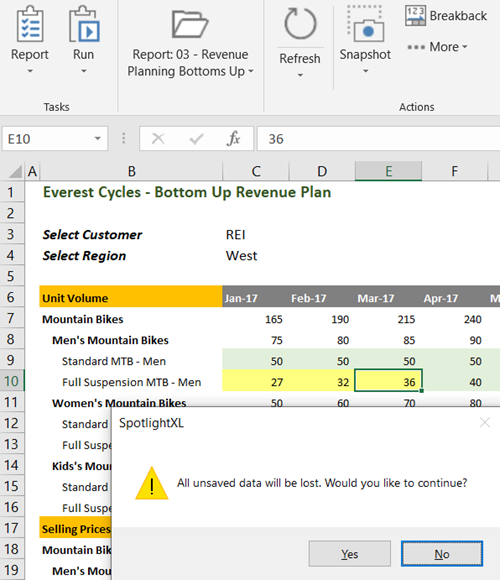
See also: Save Data.
Taking a Snapshot of a Report
Use the Snapshot item on the menu ribbon to take a picture of a report and keep it or share it with other users.
Note:
You cannot interact with a snapshot as though it was a report. It is like an image of the report only.
Select from two options.
Select Save to save the snapshot to the report folder structure.
Select Email to receive an email with a link to the snapshot, which you can share with other users of the application.
Saving the Snapshot
When you select Save, the snapshot is automatically named after the report and appended with a date and time stamp.
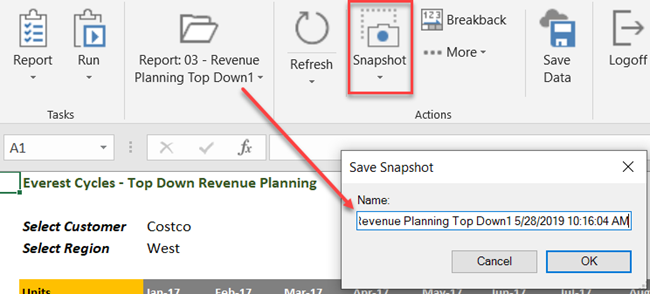
There is a dedicated folder called Snapshot in the folder structure that all snapshots are saved to. Snapshots in the Snapshot folder are stored alpha-numerically.
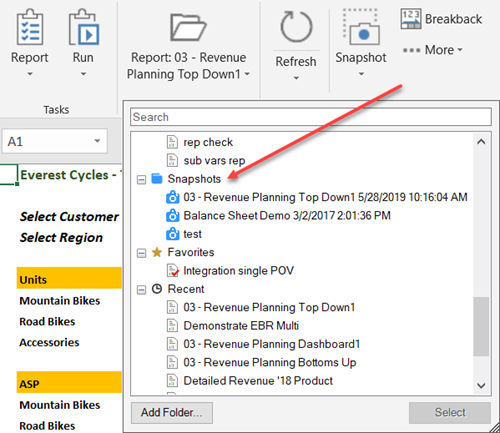
Snapshots are not backed up when you perform a model backup. So, when you restore a model you will not see the snapshots that are saved in the model. Snapshots can be viewed in SpotlightXL and Spotlight (the web front-end).
Providing Access to Saved Snapshots
Reviewer and Contributor users must be given access to view a saved snapshot. To provide Reviewers and Contributors with access:
In Practice: Providing Reviewers and Contributors with Access
Access the Manage task and the Group Management, Group Access subtask.
Select the Snapshot artifact.
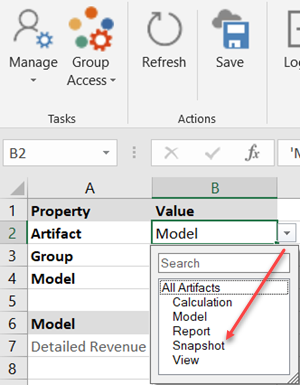
Select the Group that you want to provide with access to the snapshots for the model you select in the Model field.
Once you select you will see the list of saved Snapshots along with the available groups and then you can provide access to each group by selecting or typing ‘Yes’.
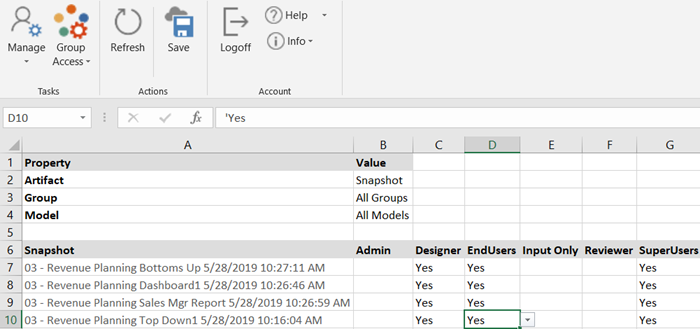
Power Users have access to all saved snapshots.
Deleting Snapshots
Saved snapshots can be deleted from the snapshots folder by selecting the snapshot, right-clicking, and selecting Delete.
Audit Log for Snapshots
Every time a user saves, emails, or deletes a snapshot, an audit entry is created in the Audit Log as shown below. The Audit Log can be accessed by selecting the Manage task and the Application Administration, Audit Log subtask.

Emailing a Snapshot
Once the link to the snapshot is emailed to the user, it will expire after 72 hours. Within that timeframe, the same user can forward that email (containing the link) to other team members or management for collaboration and review. There is no group access security applied to emailed snapshot links, which is different when compared with saved snapshots. For Saved Snapshots the Power User needs to provide group access so that Contributor & Reviewer users can access the saved snapshots.
Users who want to access the Snapshot from the email needs to be authenticated, So if the user is not logged into the Dynamic Planning application the system will ask the user to provide his login credentials and once the user is authenticated it will open the Snapshot.
If the user is already logged into the Dynamic Planning application then by clicking the snapshot link in the email will open the Snapshot.
Also, unlike the saved snapshots, emailed snapshots are not available in the Snapshots folder.
Tip
When opening a snapshot from the emailed link, press F5 to refresh the screen for the best possible snapshot display.

